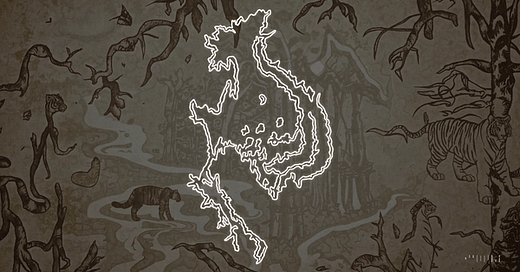Jīvṛut (જીવૃત): Multispecies Justice Rooted in South Asia
Jīvṛut, in Gujarati and Sanskrit, refers to the conduct, patterns, or ways of life.
At Lagori Collective, we’ve been sitting with the question: what kind of justice is possible in a world where most of life falls outside the frame of recognition?
This isn’t about new metaphors. It’s about confronting the systems we rely on: legal, economic, bureaucratic and asking why they still don’t see more-than-human life as part of the equation. Because even in places where the nonhuman world has long been recognised in prayer, poetry, and custom, extractive development has redrawn the map of what counts and what can be erased.
This piece emerges from the South Asian Futures work at Lagori — a framework-in-progress that explores how futures thinking can be rooted in the region’s lived realities, plural knowledge systems, and ongoing struggles. It offers tools and methods for reimagining governance, ecology, and justice from within South Asia’s contradictions, not as a model, but as a provocation. This provocation is one part of that larger process: an attempt to think out loud about what futures could look like if we began not with control, but with entanglement.
Justice in the Debris of Development
Multispecies ethics in South Asia were never just symbolic. Rivers were granted legal personality long before courts formalised the idea. Forests weren’t just sacred, they were governed through unwritten rules about when, how, and whether one could harvest, guided by seasonal cycles and ancestral obligations. In many coastal and pastoral cultures, human survival was predicated on listening closely to nonhuman cues: bird migrations, soil scent, the absence of frogsong.
But today, those relationships are being severed by speed and scale. Across the subcontinent, ecological governance is being outpaced by land acquisition laws, infrastructure corridors, and industrial agriculture. In Gujarat, pastoralist communities such as the Maldharis face restrictions in protected grasslands like Banni and Gir, often framed as encroachment. In Sri Lanka, the Mahaweli Development Scheme displaced riverine communities and fragmented elephant corridors in the name of agrarian progress. In the Sundarbans, spanning India and Bangladesh, embankment policies and rising salinity continue to sever age-old relationships between fisherfolk and mangrove ecologies.
At one of the workshops we conducted as part of a climate adaptation project, a young teacher asked: “If the banyan tree behind our school is cut down, is that an environmental issue or a cultural one?” The officials present didn’t know how to answer. There was no column in their forms for spiritual memory, no line item for loss of kin.
The languages of reverence remain, but the systems that enacted those values such as seasonal calendars, communal land norms, and multi-generational ecological observation are either delegitimised or erased.
We are not calling for a return. We are asking: how can governance acknowledge that the world is already shared? That decisions about roads, rivers, and regulations are never just about humans. They never were.
These stories are not exceptions. They point to systemic design failures.
What Needs to Change?
If South Asia holds one of the densest living archives of relational knowledge, it also sits atop some of the world’s most extractive governance structures. The tension isn’t about cultural memory. It’s about what our institutions are designed to see and what they’re structured to ignore.
Legal Erasure
Non-human life mostly appears in law as property, resource, or risk. Environmental assessments focus on compliance, not interdependence. Even landmark court rulings granting personhood to rivers or elephants often fizzle in implementation because no one knows who’s meant to act on their behalf.
Temporal Myopia
Planning cycles are short-term: three-year budgets, five-year plans, and quarterly KPIs. But ecosystems move on different rhythms. A pollinator collapse takes years to become visible. Migration routes span generations. By the time the data catches up, the damage is already done.
Epistemic Injustice
The people who know how to listen: forest communities, coastal dwellers, and herders are often treated as data points or folklore keepers. Their knowledge is referenced but rarely resourced. This weakens both conservation and governance.
These aren’t theoretical problems. They show up in Environmental Impact Assessment (EIA) hearings, master plans, disaster policies, and wildlife boards. Again and again.
Emerging Systems for Multispecies Governance
What follows isn’t a policy menu. It’s a set of sketches we’ve been developing through conversations, workshops, and field provocations. Some may be immediately testable. Others are only questions. But all attempt to reframe what governance might begin to see and who it might be accountable to.
Sentience Registries
What if governance had to keep a live record of who’s present, missing, and moving? Built by local stewards, ecologists, and communities, these registries could:
Track seasonal interdependencies
Flag early signs of ecosystem stress
Document disappearance as a policy-relevant event
Not a census but a cohabitation record.
Imagine a cross-border forest corridor between India and Nepal where seasonal sightings of langurs suddenly decline. A Sentience Registry maintained by local forest stewards flags their absence alongside a drop in native fig trees. The registry becomes evidence in halting a eucalyptus monoculture expansion and redirecting reforestation funds.
Displacement Courts for the More-than-Human
What happens when a wetland is drained or a salt pan is paved over it? These courts wouldn’t be adversarial. They’d be assemblies where affected communities, ecologists, and spiritual custodians come together to:
Trace disrupted relationships
Issue time-bound restoration mandates
Use ecological indicators to track outcomes
Imagine Karachi’s shrinking mangrove belts are cleared for waterfront development. A Displacement Court convenes fishers, mangrove ecologists, and elders to trace disrupted tidal flows and crab breeding cycles. The verdict: a six-year restoration plan linked to tidal regeneration, not land value.
Proxy Representation Networks
If rivers can’t speak in meetings, who speaks for them? Instead of tokenistic consultation, these networks would:
Mandate relational representation by people embedded in ecosystems
Rotate proxies based on season, not title
Blend data with ritual and embedded observation
Imagine in Bangladesh’s coastal chars, annual land use meetings include a ritual where fishers represent hilsa (freshwater fish) migration routes, and a women’s collective speaks for disappearing mud crabs. Proxies shift with the monsoon season and are tasked with monitoring salinity and spawning signs — blending data with ritual.
The Commons of the Uncounted
Most governance ignores what isn’t visible or profitable: soil microbes, decomposers, scavengers. This idea proposes:
Funding protections based on what’s disappearing fastest
Governance led by those most attuned to overlooked ecologies
Financing from polluter taxation and ecological debt
Imagine in Bhutan’s mid-altitude villages, farmers report a sharp decline in dung beetles and fungal blooms. A Commons of the Uncounted fund activates when a “negative space” threshold is crossed — not because these beings are economically useful but because their absence signals a deeper ecological unraveling.
Temporal Testimony Frameworks
When harm happens slowly, how do you prove it? These frameworks would allow:
Oral and intergenerational testimony as legitimate evidence
Tracking of ecological patterns (e.g., birdsong shifts)
Claims filed on behalf of beings that return seasonally or haven’t yet emerged
Imagine in Sri Lanka’s dry zone, farmers notice the herons (coastal birds) no longer arrive when the tanks fill — a pattern that once marked the start of planting season. Their memories, along with data on bird migrations and rainfall, are brought into a hearing on sand mining that’s affecting groundwater levels.
Restorative Ecologies Tribunals
When harm has already happened, these processes focus on repair:
Place-based rituals of rebalancing
Multi-year covenants tied to land and water use
Outcomes measured in return, not profit
Imagine in Uttarakhand, oak forests once managed by van panchayats (community-led forest governance) are degraded by road-widening projects. A Restorative Tribunal assembles panchayat members, foresters, and youth to design a 10-year rewilding plan tied to traditional grazing cycles and sacred grove regeneration. Success is measured not in coverage but in the return of mynahs and restored groundwater rhythms.
These speculative systems aren’t meant to replace law. They are meant to expand what the law might listen to. And while they emerge from a South Asian context, the underlying questions echo far beyond.
Global Resonance, Plural Futures
The questions we’re asking are not South Asian alone. Across the world, communities are confronting the failure of modern governance systems to account for more-than-human life. Whether in the Andes, Aotearoa, or the Arctic, efforts are emerging to embed legal personhood, relational ethics, and intergenerational stewardship into policy and law.
If the challenge is global, the responses must remain local and plural.
Let’s return to South Asia. Not as a model, but as a terrain of both offering and obstruction.
What South Asia Offers
It has longstanding ontologies that centre on co-existence — from Bonbibi legends in the Sundarbans that structure human–tiger relations to constitutional provisions that affirm duties toward “all living beings.” There have also been important legal experiments: the Uttarakhand High Court recognized the Ganga and Yamuna rivers as legal persons (though this ruling was later stayed by the Supreme Court), while the Punjab and Haryana High Court declared Sukhna Lake a living entity with rights and responsibilities. In Sri Lanka, traditional tank cascade systems have long governed water flow with seasonal sensitivity, ensuring cohabitation with aquatic and avian life. In Bhutan, Gross National Happiness includes ecological balance as a governance metric. And in Bangladesh, the 2019 declaration of the Turag River as a living entity signals growing jurisprudential traction.
What South Asia Must Confront
Conservation often reinforces elite control and enclosure. Species are politicised. River personhood is declared, but illegal sand mining continues unchecked. Plantation economies have decimated native ecologies while marginalising indigenous land claims. Even where constitutions speak of co-existence, the machinery of growth often silences both people and ecologies.
This isn’t a site of coherence. It’s a site of contradiction where traditions of relationality coexist with some of the most extractive systems of governance in the world.
The task is not to universalise these insights. It’s to enter a plural conversation. A conversation between communities who already live with more-than-human entanglement, even if their systems don’t yet recognise it. Between places experimenting with different forms of legal standing, ecological monitoring, or rights of nature from Māori guardianship models to Colombian rulings protecting the Atrato River.
The future of multispecies justice will not come from one region, discipline, or law. It will come from stitching together partial efforts — practices that are already happening, often in fragmented form, into frameworks that reflect the complex, plural, entangled realities we already inhabit.
Not a Conclusion
Multispecies justice isn’t a policy doctrine. It’s a way of practicing governance differently — across time, across forms of life, and across kinds of evidence.
We’re not offering a new rights framework. We’re naming a responsibility. One that asks:
What rhythms are we ignoring?
What disappearances have gone unnoticed?
What will it take to re-attune institutions to shared life?
As part of our South Asian Futures work at Lagori, we’re beginning to explore participatory tools, including kinship maps that help surface more-than-human entanglements in land-use planning, community decision-making, and ecological stewardship.
If you’re working on or thinking about any of this, we’d love to connect. We’re keen to share what we’re learning and learn from what you know.
Dhaval Kothari is a design researcher, strategist and co-founder of Lagori Collective. Lagori is an interdisciplinary research and design lab in South Asia that advances futures thinking and participatory innovation through collaborative projects, community programming, and strategic foresight. Dhaval applies futures thinking to address broader social issues, while retooling systems to better anticipate and prepare for emerging challenges. He is particularly focused on building a South Asian lens for futures and foresight work.
Notes From In Between is a record of our in-progress thinking, provocations, open questions, and ongoing experiments at Lagori’s Social Design Lab. It’s where we make our process public — not to present answers, but to invite conversation. Check out our first Notes From In Between - Mausam, a provocation in reimagining land not as something to be owned, but as something that moves with the world around it.






